|
Streamlined Motorcycle Cross Wind Stability: (Revision: April 9, 2012) Fully Streamlined Electric Motorcycles have the potential to get up to 1,000 MPGe. To be sold to the general public, they must be stable in cross winds (i.e. they must automatically lean into cross winds). Two streamlined motorcycles that do this are the Peaves Ecomobile and Royce Creasey's CMAX 2010. |
|
Pearves Ecomobile: The Peraves Ecomobile is a fully-enclosed, 2 wheeler that has steering and body geometry that work together to automatically countersteer into wind gusts so that the vehicle doesn't get pushed off course. Arnold Wagner's comments about the stability of the the Ecomobile: "What you see is an ECO in a Beaufort 10 / 80-90 kph crosswind, in a "full storm" situation. It's one of ~ 250 test runs in the Daimler-Benz and BMW-crosswind facilities. We have proof that the max. deviation (not from the black tire marks but from the yellow median dots) is ~ 2 feet while the K100-reference motorcycle 1 min. later had 6 feet. This is the point of maximum deviation from where the ECO comes back automatically with no steering input but free handlebars. We even did tests with 2 pairs of skis on a roof rack on the ECO and only then the deviation got in the same magnitude as for conventional motorcycles. With my electronically controlled vertical stabilizer there's another deviation reduction by 50%..." Arnold Wagner "...The vehicle does NOT start to incline away from the crosswind direction, but leans automatically into the wind, the more forward the LCP (longitudinal center of pressure) the more leaning against the wind. The reason is, that the trail of the steering produces a steering moment into the wind by counterdeflection that causes a roll input at least 3 times greater than the moment ..." Arnold Wagner 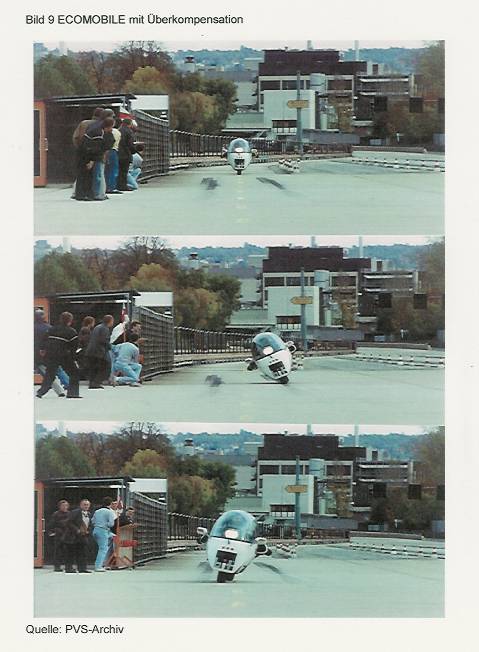 Kraig Schultz asked asked Dan Whitfield about the self-correcting behavior of his ECO in sidewinds (Dan has driven his Ecomobile all over the United States): Dan responded: "Yes, the ECO does just as Arnold says. It moves toward the wind due to the forward center of pressure. However, the pressure/vacuum does try to push the bike sideways like a sail. The air scoops on the left and right sides at the front of the engine compartment give this air a place to go through the vehicle (pressure to vacuum side) and reduce the pressure/vacuum which tries to slide the tires. I have ridden in 50+ MPH cross wind for about 100 miles (tractor trailers were being blown over) and it was a hard fight to keep the bike heeled over against the wind (It was the first time I had ever rounded a 75 MPH right hand bend in the highway while leaning hard left). Cheers, Dan Whitfield" Dan's story was verified by Ernie Buckler: "When he came here to visit, I was planning on riding a Honda 500 CX Turbo out to meet him, but it was terribly windy, like 50mph stuff that was blowing the fully-faired CX all over the road. I called him and he said not to worry, he'd find my place OK. Which he did, said yes, it was a work-out in the wind, but nothing he couldn't control or deal with. There's even a video showing the Eco undergoing a sidewind test at the BMW proving grounds, where the Eco rides past a wall with giant fan blowing across the Eco's path; the Eco tilts quickly into the wind but wheel track only moves about a foot, maybe less. You also most definitely want to look at Royce Creasey's videos on Bike Web, his Voyagers have excellent sidewind stability, took many years to achieve. HPV site is also informative about side winds - bicycle streamliners got blown over a LOT until they figured out what not to do. Even the Gold Rush got blown over at 50mph with 25mph sidewind, but that was because it didn't have enough steering lock. Vetter's first economy runs along CA Hiway 1 had a lot of blow-overs as well..." Dan's Ecomobile's stability is also verified by Craig Vetter: "Dan took me for a long ride in his Ecco on a very blustery day and I never felt any problems! It was amazing." Here is our Delta-11 concept compared to the Ecomobile for general size. 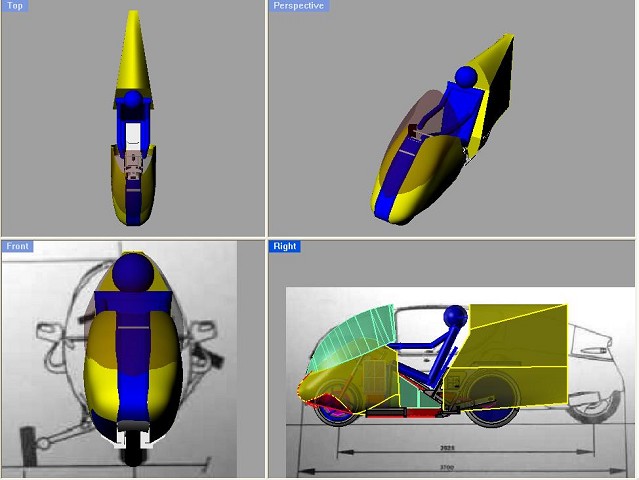 |
|
Royce Creasey's Bikes: Royce Creasey of England has developed cross-wind stable, feet forward motorcycles over the course of the last 30 years. To see some of his work in detail visit: http://www.bikeweb.com/image/tid/10 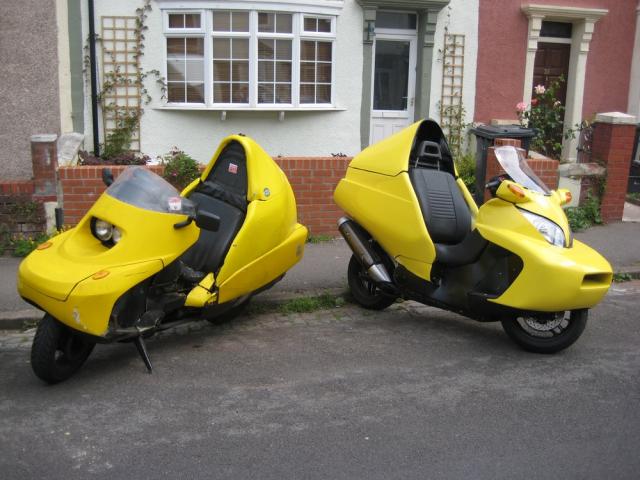 Royce has this to say about cross-wind stability: "...it's the deflection of the steering under sidewinds loads that causes the self-correcting effect you see in the Eco sidewind test - as he says, this is a major wind blast test. We've had to use the Severn Bridge for sidewinds testing in the past, but the results are pretty much the same with Voyagers. However. For this effect to take place various other features have also to be in place. If there is too much side area at the front the vehicle can be blown out of the wind. If there is no tail, or the tail area is masked by turbulence or too small, the vehicle may not weathercock and may also be blown out of the wind. Various people have succeeded in building stable shapes and these shapes vary considerably, but they all visibly balance nose and tail side area and several have features that might be expected to separate flow across the nose - including the Monotracer. ...I do not doubt that it is entirely possible to build both fully enclosed and partially enclosed vehicles that will have safe and predictable handling in any side wind that it would be reasonable to drive in (after about 50 mph you have to worry about the lumpy bits in the wind). My view is that this is accomplished in each unique shape by basic attention to side area ruling, followed by the addition of suitable separation features to insulate and damp the majority of buffeting caused by turbulence etc. Resulting shapes may not follow strict laminar flow rules, but road vehicle operate in mainly dirty air, correct separation will reduce drag and improve 'indifference'. I suggest that the height of the side area is important, in a sidewind there is a force tending to roll the vehicle away from the wind as well as the side loading that deflects the steering. This 'rollout' force should be minimized and this has been done by keeping the nose area fairly low and separating the airflow from the downwind side of the nose... Cheers, Royce" Here is our Delta-11 concept compared to the one of his bikes for general size. 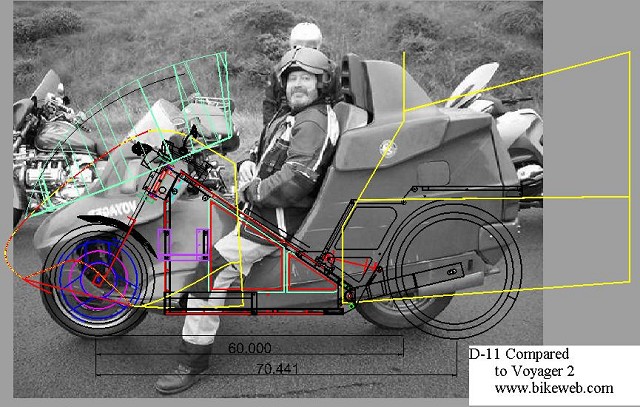 |
|
Things to avoid - Nose overhang The NSU Baumm Streamliner is well known as one of the most aerodynamic motorcycles ever built. Learn about it's incredible performance Click Here From Mick Walker's German Racing Motorcycles By Mick Walker From http://www.bikeweb.com/node/1805: About this design, ...Arnold commented: "Round at the front has nothing to do with head or feet first. It's a necessity to get decent crosswind behaviour. The BAUMM streamliners and other record breakers sinned by pointed front ends and long overhang before the front wheel to get the cross section down. They were instrumental for the bad crosswind characteristics attributed to fully faired motorcycles. I still do not know of any measurements in crosswind facilities like Daimler's at Untertürkheim and BMW's at Ismaning except of our own with ECOs. This means that so far only we have the knowledge how to design a good and practically useful front end supported by our testing and calculating evidence. Best ARNOLD www.monotracer.ch/site"  |
|
Things to Avoid. High front and no tail. Per Kraig Schultz: The Delta-11: 2011 without a tail had a barely perceptable ability to automatically lean into the wind. But the feedback loop is not self-correcting and in wind gusts over 25mph, the rider must actively monitor and countersteer correctly to lean into the wind or the bike is taken off course.  |
|
May 28, 2012 Update for Delta-11 Per Kraig Schultz: Here's a picture of my bike as I rode it on May 28th to go get supplies. It was quite gusty. Instead of trying to countersteer I began experimenting with just keeping the throttle open and letting the bike lean the way it wanted to when being tossed by the wind. What I found was that the bike is able to respond instantly to the cross winds and it leans into them. My job is to keep the throttle open and "hold on loosely" and keep my body sitting on top. If I lean with the bike or try to countersteer it gets all dangerous and really scary. The bike responds automatically to the winds much quicker than I can, and when winds switch back and forth from one direction to the other, the bike leans the direction it needs to to stay on course. Some things to be aware of. The bike had the storage bag attached just as shown and there was a lot of weight up top on the rear (40# of charging equipment in the black box, plus another 8# of gear in the bag storage bag on top) More research and experimentation is required to understand what shape works best and how the weight distribution affects handling in crosswinds. But, this ride was an important data point in my learning. 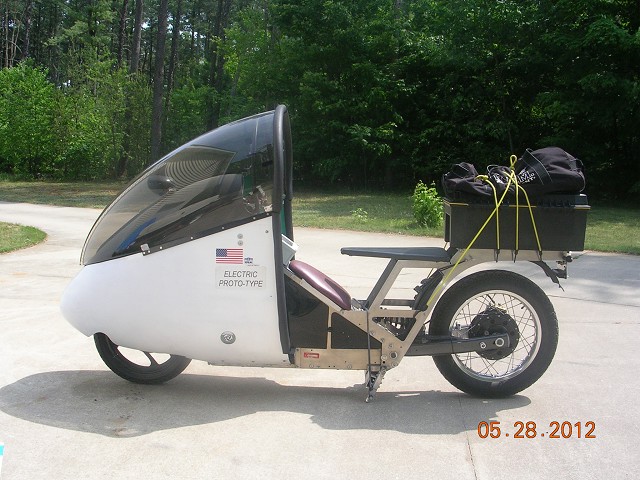 |
|
Traction on Wet Roads A common concern of various streamliner owners is traction. In heavy sidewinds how much can a vehicle lean into the wind and still expect to keep the rubber side down? Cedric Lynch had this to say about his streamliner: "In my streamlined motorcycle you certainly feel cross-winds but get used to them. It feels rather like being in a small sailing boat. Up to a wind speed of about 30mph it is OK but if the wind is stronger than that I cannot use the vehicle; this happens on average on two or three days a year near London. The amount of lean that is needed in a wind over 30mph is such that if the road is wet there is a risk of losing grip. The all-up weight is under 200kg (440lb); either the weight would need to be increased, or the side area and/or drag/lift coefficient in side winds would need to be decreased in order to overcome this problem. I think having the center of gravity higher up also helps, and having it further forward certainly does. I am thinking of building a new improved version of the vehicle, and this will have front wheel drive and the weight well forward." Cedrics bike is the one in the middle of the picture below:  Craig Vetter had this to say about traction: "Traction: I have been in situations where I feared that the front wheel would break traction. It never has. Motorcycles and cars sometimes are blown into the ocean at my favorite test road, Hurricane Point, Big Sur where gusts can be 50 mph from one side and then the other. I suspect that these vehicles lost traction because of wet roads. Worse would be on a metal grate bridge. On dry roads, it can be scary but manageable if you slow down. I would stop or go home. So... Regular bikes can blown off course. After all is said and done... the solution seems to be slow down. If the roads are wet, stop riding" Kraig Schultz had this to say about riding in strong side winds: "The problem is wind direction and velocity changes so quickly that the rider cannot manually intervene. The bike must do the right thing automatically. There is a threshold where gusting crosswinds are dangerous even on a normal bike. When gusting cross winds exceed 30mph they can really start to push you around. A 30mph gust is the kind of gust that will catch you when standing up on the ground and make you take a step backwards because it hits you hard. It's also the kind of wind that makes you wonder if your bike might tip over when you are leaving it in the parking lot to go shopping inside the store. Riding crouched over close to the bike helps reduce the power of the wind acting on you (because the cross winds are mostly grabbing at the torso of the rider on a regular bike). To measure wind forces, we use a great little wind gage from Dwyer-Instruments. It has instantaneous response to wind gusts and can measure windspeeds from 0 to 60 mph...Probably the most interesting thing we've learned from the wind gage is that the same type of gust that tosses a bike around while riding (25-30mph gusts) creates scary tipping forces while stopped on the side of the road. So, really we can do all kinds of experiments with wind gusts with less risk of crashing...by just sitting on the side of the road balancing the bike with our feet. Passing traffic creates disturbances in the wind patterns just like when riding." |
|
Changing Motorcycle History Starting Today... Copyright 2011, 2012, Delta Bike USA |